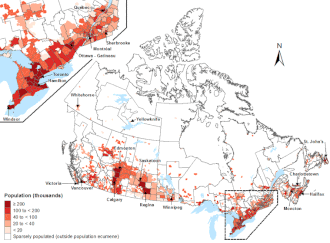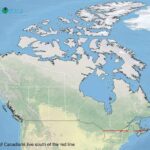
Canada’s Population Growth Hits Historic Low as Immigration Tightens
Canada’s latest quarterly population data highlights the clear impact of federal immigration restrictions introduced in 2024 and 2025. According to Statistics Canada, the country’s growth between April 1, 2025, and July 1, 2025 slowed to a near standstill, signaling the most dramatic slowdown in years.
Key Highlights
- Quarterly Population Growth Falls to 0.1%
- From April 1 to July 1, 2025, Canada’s population grew by 47,098 people, representing a 0.1% growth rate.
- This is the weakest second-quarter growth since 2020, when population growth almost stopped during the COVID-19 pandemic.
- Impact of New Immigration Policies
- Starting in 2024, the federal government introduced multiple measures to reduce population growth driven by immigration:
- Cap on study permit applications.
- Stricter eligibility for work permits.
- 20% reduction in permanent resident (PR) landing targets.
- First-ever targets for temporary resident admissions.
- Starting in 2024, the federal government introduced multiple measures to reduce population growth driven by immigration:
- Immigration’s Contribution to Growth Drops Sharply
- Immigration accounted for 71.5% of population growth in Q2 2025, down significantly from 95.3% during the same quarter in 2024.
- While immigration continues to drive most of Canada’s growth, the declining percentage reflects tighter entry controls.
Population Growth Trends – Year-on-Year Comparison
| Year | Population Increase | Growth Rate (%) |
|---|---|---|
| 2022 | 257,123 | 0.70% |
| 2023 | 321,791 | 0.80% |
| 2024 | 272,032 | 0.70% |
| 2025 | 47,098 | 0.10% |
The sharp decline in 2025 clearly shows the effect of Canada’s immigration and temporary resident restrictions.
Decline in Temporary Resident Population
Canada’s non-permanent resident (NPR) population continues to shrink for a third consecutive quarter.
- As of July 1, 2025, there were 3,024,216 non-permanent residents, representing 7.3% of the total population, down from 7.6% on October 1, 2024.
- This decline aligns with the government’s goal of reducing temporary residents to 5% of the total population by 2026.
Breakdown of Declines in Q2 2025:
| Category | Net Change (Apr–Jul 2025) |
|---|---|
| Study permit holders only | -32,025 |
| Work permit holders only | -19,637 |
| Holders of both study and work permits | -19,072 |
Federal Measures Reducing Temporary Residents
The following immigration policy changes have fueled the decline:
- Cap on study permit applications to control international student intake.
- Pause on low-wage Labour Market Impact Assessments (LMIAs) in regions with unemployment rates of 6% or higher.
- Tighter eligibility for Spousal Open Work Permits (SOWP).
- New restrictions on Post-Graduation Work Permit (PGWP) eligibility.
Temporary Resident Targets: 2025–2027
Canada’s latest Immigration Levels Plan (2025–2027) aims to reduce the number of temporary residents while easing pressure on housing and social services.
| Year | Target for Temporary Resident Admissions |
|---|---|
| 2025 | 673,650 |
| 2026 | 516,600 |
| 2027 | 543,600 |
The government has committed to lowering the temporary resident share of the population to 5% by the end of 2026.
Decline in New Arrivals – 2025 vs 2024
The IRCC data shows steep drops in new arrivals compared to 2024:
- Worker arrivals down 37% (July 2025 vs. July 2024).
- Student arrivals down 55% in the same period.
- Between January and July 2025, Canada admitted:
- 98,070 fewer students.
- 137,000 fewer workers than during the same period in 2024.
Key Takeaway
Canada’s slowed population growth reflects a deliberate government strategy to balance immigration with infrastructure, housing, and social service demands. While permanent residents continue to drive growth, the decline in international students and temporary workers indicates a significant shift in Canada’s immigration landscape.
For a consultation about Immigration options, reach out to the CAD IMMIGRATION today!





